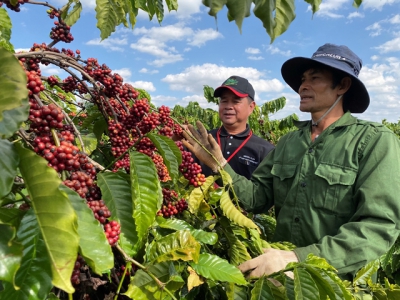Nestlé programme helps increase coffee farmers incomes

Ho Chi Minh City — In the 10 years since it began NESCAFÉ Plan, a public-private partnership programme between Nestlé, the Ministry of Agriculture and Rural Development, the Western Highlands Agriculture and Forestry Science Institute and other partners, has helped improve the quality of coffee beans and increase farmers’ incomes by 30 per cent.
A coffee garden of a farmer in Gia Lai Province who is participating in the NESCAFÉ Plan. In the past 10 years, the programme has made significant contributions to Việt Nam’s coffee industry. — Photo courtesy of Nestlé
It has so far distributed 46 million high-yield, disease-resistant coffee saplings to farmers and helped rejuvenate over 46,000ha of aged coffee plantations in the Central Highlands, Phạm Phú Ngọc, chief representative of Nestlé Vietnam office for the region, said.
It has also provided training to over 260,000 coffee farmers in best practices to improve quality and ensure sustainable farming and helped over 21,000 farmers achieve 4C international certification, he said.
Besides, it helps protect the environment by reducing water use by 40 per cent and fertiliser and pesticide use by over 20 per cent, he added.
Todd Yates, technical director, Nestlé Vietnam, said: “Through NESCAFE Plan, we have also helped further strengthen the reputation of Việt Nam as a source of high-quality coffee. Nestlé uses coffee beans produced by farmers under the NESCAFÉ Plan in many of our products which are, in turn, distributed to more than 25 countries across Asia, Europe, the Americas, and Oceania.
“This includes markets with very high standards for quality and compliance such as Japan, Korea, the United States, and several countries in the European Union.”
Phan Tấn Luyện, a farmer in Eaktur Commune, Đắk Lăk Province, said: “Following the instructions from the programme’s experts has helped me reduce irrigation costs and use fertilisers properly.
“I have also learnt how to make organic fertiliser from coffee husk to fertilise our coffee trees, which helps reduce disease and increases productivity from three tonnes per hectare previously to 4-4.5 tonnes now.”
Nguyễn Hắc Hiển, deputy director of the Đắk Lắk Province Crop Protection Department, said: “The programme has brought practical benefits to coffee farmers in Đắk Lắk, the country’s largest coffee cultivation locality.”
But the province’s coffee sector faces several problems such as small scale of production, ageing coffee trees, poor quality control, and impacts of climate change, he said.
The province has implemented a programme to develop its coffee sector in a sustainable manner. It seeks to enhance co-operation with the NESCAFÉ Plan to help develop its coffee sector, he said.
Binu Jacob, CEO of Nestlé Vietnam, said “Despite the NESCAFÉ Plan’s achievements from the past decade, we are not content to rest on our laurels. We believe that Việt Nam, while already the world’s top producer of Robusta coffee, still has a lot of potential to grow.”
His company would continue to add value to Vietnamese coffee by increasing the volume of processed coffee for both the domestic and export markets.
It would work with farmers and other coffee stakeholders to improve and monitor agricultural practices and expand the adoption of sustainable farming methods, drive the circular economy by strengthening sustainability across the coffee value chain from farming to production and bring new product choices to young and demanding local consumers.
“We aim for the NESCAFÉ Plan to help deliver one of Nestlé’s overall goals which is to unlock the power of food to enhance quality of life for everyone today and generations to come.”
Nestlé is the biggest buyer of coffee in Việt Nam, buying about 20-25 per cent of the country’s total output or $600-700 million worth a year.
Có thể bạn quan tâm
 Vietnam struggles to deal with low coffee value
Vietnam struggles to deal with low coffee value The lack of quality processed coffee for export and a neglected domestic market are preventing Vietnam from creating a recognisable coffee brand to the world.
 Vietnam may be allowed to ship fresh longans to Australia from 2019
Vietnam may be allowed to ship fresh longans to Australia from 2019 Vietnam may get the green light to export fresh longans to Australia from 2019, after lychees, mangoes and dragon fruits.
 Two-month pepper export turnover reaches 138.8 million USD
Two-month pepper export turnover reaches 138.8 million USD Vietnamese pepper products have been exported to 100 countries and territories, with Asia, Europe and the US being the biggest markets
 Organic rice project underway in Hai Phong
Organic rice project underway in Hai Phong The Thuan Loi Limited Company has launched a high-tech organic rice farming model in Hai Phong’s Kien Thuy district, the first of its kind in the northern city.
 Quang Ngai boosts sustainable agricultural development
Quang Ngai boosts sustainable agricultural development Producing organic and safe agricultural products with hi-technological application is an inevitable trend in the context of international integration